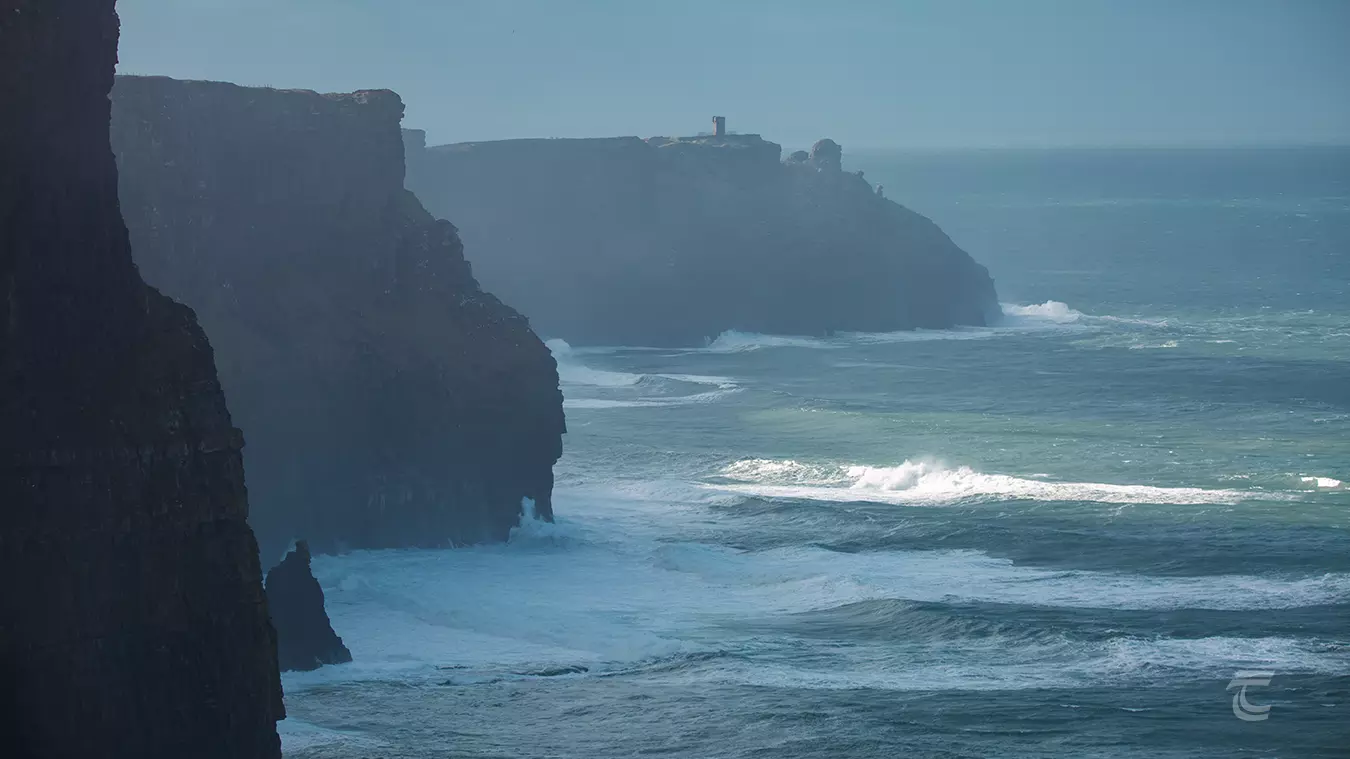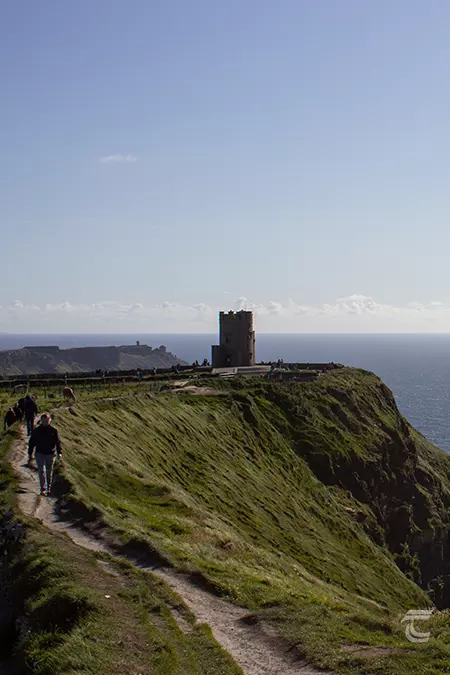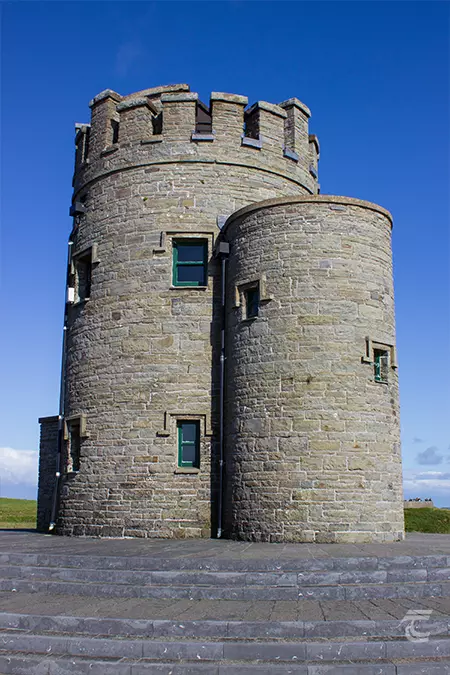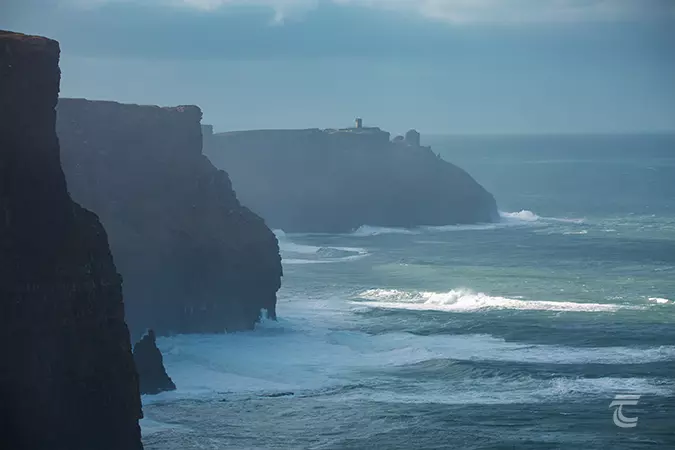The Cliffs of Moher
The Cliffs of Moher have become one of Ireland’s most popular visitor attractions and a truly iconic landmark. The cliffs soar 120m (390 feet) above the roaring Atlantic Ocean, and are so dramatic in their appearance that they have featured in a number of major motion pictures, most notably as the feared Cliffs of Insanity in the popular fantasy adventure film The Princess Bride (1987), and in Harry Potter and the Half-Blood Prince (2009) as the exterior of an enchanted cave containing a Horcrux.
The different compacted layers can be seen in the different coloured bands that stretch horizontally across the cliffs. The lighter coloured rock is Namurian Sandstone and the darker coloured bands are siltstone and shale. Each line of rock is a time capsule, containing fossils of plants, insects and marine animals that were trapped between the layers of sediment millions of years ago.
Due to its sedimentary makeup, the stone breaks into large sheets or flags, which are ideal for building materials. For many years humans have quarried this rock and used it to build houses, decorate fireplaces, and even tile roofs. Perhaps the conveniently breakable stone was used over a thousand years ago to build Ó Ruaín’s fort here on the cliffs. This fort which has now been destroyed was known in Irish as An Mothar Uí Ruaín meaning ‘the ruin of Ó Ruaín’. Over the centuries, An Mothar Uí Ruaín was shortened to An Mothar and soon became known in English as the Cliffs of Moher.
For practical information about visiting this site Click Here
The Cliffs of Moher have become one of Ireland’s most popular visitor attractions and a truly iconic landmark. The cliffs soar 120m (390 feet) above the roaring Atlantic Ocean, and are so dramatic in their appearance that they have featured in a number of major motion pictures, most notably as the feared Cliffs of Insanity in the popular fantasy adventure film The Princess Bride (1987), and in Harry Potter and the Half-Blood Prince (2009) as the exterior of an enchanted cave containing a Horcrux.
The different compacted layers can be seen in the different coloured bands that stretch horizontally across the cliffs. The lighter coloured rock is Namurian Sandstone and the darker coloured bands are siltstone and shale. Each line of rock is a time capsule, containing fossils of plants, insects and marine animals that were trapped between the layers of sediment millions of years ago.
Due to its sedimentary makeup, the stone breaks into large sheets or flags, which are ideal for building materials. For many years humans have quarried this rock and used it to build houses, decorate fireplaces, and even tile roofs. Perhaps the conveniently breakable stone was used over a thousand years ago to build Ó Ruaín’s fort here on the cliffs. This fort which has now been destroyed was known in Irish as An Mothar Uí Ruaín meaning ‘the ruin of Ó Ruaín’. Over the centuries, An Mothar Uí Ruaín was shortened to An Mothar and soon became known in English as the Cliffs of Moher.
For practical information about visiting this site Click Here

The Cliffs of Moher • Clare
A Living Landscape

Path to O’Brien’s Tower, the Cliffs of Moher • Clare
Though they may look immense and immovable, the Cliffs themselves are not a static entity. Coastal erosion continues to sculpt these magnificent marvels. The stormy Atlantic relentlessly chews away with every wave, breaking down some of the lower strata of softer stone and causing sections of the cliffs to collapse. This can be seen at the Branaunmore sea stack, a free-standing pillar which is all that remains of a collapsed section of cliff, whose layers of stone now lie beneath the waves.
The visitor centre contains interactive exhibitions that detail the geology and wildlife of the cliffs, with information about the colonies of tens of thousands of seabirds that make the dizzying cliffs their home. Visitors can enjoy the spectacular Cliff Walk (though please be sure to take the official path as the unofficial path that tracks along the cliff edge is prone to collapse and is highly dangerous). On the walk you will encounter O’Brien’s Tower, a folly constructed in 1835 as an observation point and tea room by the enterprising local landlord, Sir Cornelius O’Brien. Local stories tell that he had the tower built as a romantic retreat to impress a local lady he was courting. If the weather conditions are favourable you can enjoy an unforgettable view of the cliffs from the water on a boat tour from Doolin.
Though the waters of the Atlantic can be wild and unpredictable, this part of the ocean is home to a wonderful array of wildlife. Between April and August, these waters are frequented by the second-largest fish on the planet, the basking shark. These sharks have long lifespans and can grow up to 12 meters or 39 feet in length. They have enormous jaws that open up to 1 meter wide but thankfully, these sharks only eat plankton and small fish. The waters are also home to blue sharks, porbeagle sharks, and the lesser spotted dogfish, as well as bottlenose dolphins, harbour porpoise, and if you are very lucky, you might even catch a glimpse of a distant humpback whale.
As impressive as the underwater world is, the Cliffs of Moher are perhaps most famous as an important sanctuary for seabirds. They are home to over 30,000 pairs of seabirds during the nesting period from April to July. The Cliffs are designated as a special protected area for birds, for the populations of guillemot and razorbill as well as significant numbers of puffins, kittiwakes, and fulmar. Though the squawks and screeches can be deafening near their cliffside nests, you’ll rarely hear them as they hunt. They silently swoop, circle and plunge into the water to catch their prey. Some of these impressive birds are spectacular divers, especially the guillemots who can descend from sitting on the surface to descend to up to 180 meters, nearly 600 feet, below the water surface. Almost as deep as the height of the Cliffs of Moher!

Path to O’Brien’s Tower, the Cliffs of Moher • Clare
Upper left: The Cliffs of Moher from the waves • Lower left: The dramatic West Clare coast • Right: O’Brien’s Tower
Top: The Cliffs of Moher from the waves • Middle: O’Brien’s Tower • Bottom: The dramatic West Clare coast






